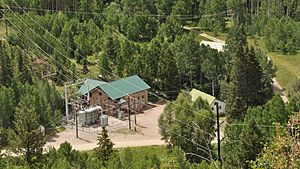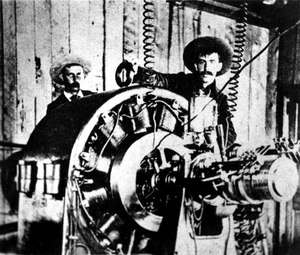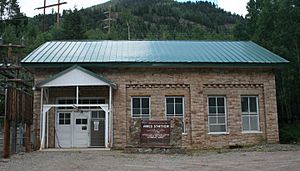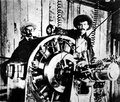Ames Hydroelectric Generating Plant facts for kids
Quick facts for kids Ames Hydroelectric Generating Plant |
|
|---|---|

Ames Hydroelectric Generating Plant in 2011
|
|
| Location | Ames, Colorado, United States |
| Coordinates | 37°51′52.88″N 107°52′55.18″W / 37.8646889°N 107.8819944°W |
| Status | Operational |
| Commission date | 1891 |
| Owner(s) | Xcel Energy |
The Ames Hydroelectric Generating Plant was built in 1890 near Ophir, Colorado. It was one of the very first places to make and send alternating current (AC) electricity for industrial use. It was also one of the first AC hydroelectric plants ever built.
The plant started working in 1891. It was built by Westinghouse Electric. They used two large alternators (machines that make AC power). One was in the valley, powered by water. It sent electricity 2.6 miles (4.2 km) through a power line. This power went to the Gold King Mine. There, the second alternator worked as a motor to run the mining machines. The Ames plant has been updated over the years. It is still working today! It is now recognized as an IEEE Milestone for its importance in electrical history.
Contents
History of the Ames Power Plant
Why the Plant Was Needed
The Gold King Mine needed power for its stamp mill. A stamp mill crushes ore to get out valuable metals. The mine was high up in the mountains, about 12,000 feet (3,658 meters) high. It was hard to get wood for steam power there. Coal was also not an option because there was no railroad to the mine.
Lucien L. Nunn, a major owner of the mine, wanted a cheaper way to power the mill. The San Miguel River was 3,000 feet (914 meters) down the slope. It was about 3 miles (4.8 km) from the mine. This river looked like a good source of water power.
Choosing Electric Power
Lucien's brother, Paul Nunn, was an electrical engineer. He started looking into using electric motors. A 220-volt direct current (DC) system was too costly. It needed very thick copper wires to send power over such a long distance.
A high-voltage alternating current (AC) system seemed much better. So, in 1890, they contacted Westinghouse Electric in Pittsburgh, Pennsylvania. They convinced Westinghouse to provide an AC power system for the mine.
Building the First AC System
Westinghouse engineers and students from Cornell University designed and installed the AC system. The equipment arrived in the summer of 1890. The engineers installed it that winter.
The system used two identical 100-horsepower (hp) Westinghouse single-phase alternators. These were the biggest ones the company made then. One alternator was set up in a generator house in Ames. This was where the Howard Fork and Lake Fork streams joined to form the San Miguel River.
This generator made 3,000 volts of 133 Hertz, single-phase AC power. It was powered by a six-foot (1.8-meter) Pelton wheel. Water from the streams and natural reservoirs flowed down a 320-foot (98-meter) drop through a 2-foot (0.6-meter) steel pipe to spin the wheel.
Sending Power to the Mine
The electricity traveled 2.6 miles (4.2 km) up the mountain to the mine. It went through two bare copper wires on poles. The wires were held up by insulators. The cost for the wires was about $700. This was only about 1% of what a DC power line would have cost!
At the mine, the second 100-hp Westinghouse alternator was used as a synchronous AC motor. It powered the stamping mill. A smaller induction motor was also installed. This smaller motor was a new type of motor. It was based on patents Westinghouse had from Nikola Tesla. It helped start the larger alternator.
Running the Plant
The power system began working on June 19, 1891. It ran non-stop for the first 30 days. About 15 to 20 people were needed to operate the plant. The controls were very basic. Workers had to be careful because of the high voltages.
Connecting power was done by closing simple knife switches. To shut down the system, a worker would pull a connecting line off a pole. This was sometimes dangerous and could create long, bright electric arcs.
One big problem was damage from lightning strikes. These were common in the mountains. Engineers tried different types of lightning arresters. The alternators were designed so parts could be removed. This made repairs easier.
Plant Upgrades and Ownership Changes
Because the plant was so successful, the Nunn brothers built similar systems at their other mines. In 1896, the Ames plant was rebuilt. It got a new three-phase system with new generators and induction motors. They also added step-up transformers to boost the power to 10,000 volts. This allowed power to be sent even farther. The water supply was also made larger.
The Ames plant became part of the Nunn’s Telluride Power Company. This company later joined Western Colorado Power Company. This company then became part of Utah Power and Light. In 1992, Public Service Company bought the plant. Today, it is owned by Xcel Energy.
A power house built in 1905 is still in use today. It has two Pelton wheels that power a single 1904 General Electric generator. This generator makes 2,400 volts of power.
Why the Ames Plant Was Important
The Ames power station was built at a time when alternating current (AC) was becoming very popular. Westinghouse Electric was competing with other AC companies. They were also competing with Thomas Edison's direct current (DC) company. There was even a "war of currents" between Westinghouse and Edison.
Westinghouse Electric saw the Ames project as a great way to show how well their AC system worked. They had been developing it since 1886.
The 1891 Ames Hydroelectric Generating Plant is one of the oldest power plants. It was one of the first to make and send alternating current for industrial use. It started working one month before a famous German power system. That system sent power from Lauffen Dam to Frankfurt.
Other hydroelectric plants came before Ames in some ways. The Willamette Falls Electric Company in Oregon started in 1889. It was the first AC hydroelectric plant. It sent power 14 miles (23 km) to Portland, Oregon, for arc lighting. The oldest hydroelectric plant to supply AC power for a commercial system was in Thorenberg, Switzerland. It started in May 1886. It sent 1,800 volts of power almost 3 miles (4.8 km) to light up hotels in Lucerne.
The original Ames/Gold King plant is also special for its small starter motor. This was an early use of an induction motor. This new type of motor did not need a commutator. It later became very common. Westinghouse had licensed the patent for this motor from Nikola Tesla two years earlier.
See Also
- Historic American Engineering Record (HAER) No. CO-2, "Ames Hydroelectric Plant, Ames, San Miguel County, CO", 10 photos, 2 data pages, 1 photo caption page
Images for kids










